
South Korea (hereafter “Korea”) was one of the world’s poorest countries in the 1950s. Today, it has the tenth-largest gross domestic product in the world. Korea’s conglomerates, known as chaebols, are famous. The five largest (Samsung, LG, Hyundai, SK Group, and Lotte) control two-thirds of all Korean exports.
However, these same conglomerates also played a major role in catalyzing the Korean financial crisis in 1997. In response, Korea was forced to take on a record level of International Monetary Fung debt ($58 billion) and submitted to an IMF round of induced “restructuring,” which reduced workers’ wages and caused unemployment to grow rapidly from 2.1 percent in October 1997 to 7.6 percent by July 1998.
Facing this crisis, new social economy movements emerged in Korea, not only as an immediate response to the neoliberal economic crisis, but also as a visionary long-term alternative for building a different kind of economy. Over the past quarter century, a second economy—known variously as the “social economy” or “social and solidarity economy”—has emerged.
Today, Korea’s social and solidarity economy is increasingly mature—with a system of national legislation supporting four types of solidarity economy enterprises: self-sufficiency enterprises, social enterprises, village community enterprises, and cooperatives. Here is the story of their development.
Self-Sufficiency Enterprises
The grassroots response to the economic crisis in 1997 was extraordinary.
Self-sufficiency enterprises (also known as self-reliance centers) were the first solidarity-economy institution to emerge out of the 1997 crisis. They began with the aim of minimizing unemployment.
For context, the grassroots response to the 1997 economic crisis was extraordinary. For example, Korean citizens mobilized to donate 227 tons of their personal gold items (with an estimated total value of $3 billion) to help pay off the debt.1 This citizen activism prompted government action to honor the sacrifice. Specifically, $90 million of the liquidated gold (about three percent of the total) was dedicated to a workers’ welfare fund, with part of the proceeds used to help create the “People’s Movement Committee for Overcoming Unemployment.”2
Self-sufficiency enterprises predated the crisis. As Lee Byung Hak, president of Central Self-Sufficiency Fund, explains, these small self-help enterprises, or makeshift cooperatives, were created before 1997 “to make ends meet in a communitarian way.” Often, groups of residents would come together to cooperatively seek and share work in sectors like construction and housecleaning or to market locally produced goods. By sharing opportunities and challenges, impoverished workers found ways to make ends meet. But these “self-sufficiency productive communities” struggled mightily for capital and adequate business opportunities, particularly as the economic crisis hit. Government support was required.
In response, the Korean National Assembly passed the National Basic Living Standards Act of 1999, which became a centerpiece of state-funded efforts to “institutionalize workers’ productive communities, including self-sufficiency support systems for the poor.” With government support, the number of self-reliance centers grew rapidly, peaking at 1,760 by 2016. Although their number has since fallen to 970 centers (as of February 2022), these self-reliance centers mark the beginning of the rise of Korean “social economy” infrastructure.
Social Enterprises
The Social Enterprise Promotion Act, passed in 2007, was more far reaching. SEPA became the first “social economy” law in Asia to address traditional-market failures and bring social objectives into a broader range of government-supported economic enterprises. SEPA authorized legal recognition, government funding, and other support for certified social enterprises—democratically governed initiatives that seek to do business in ways that advance social well-being.
Subsequently, a wide range of government agencies and programs began to support and vigorously promote social-economy enterprises. This support included: 1) direct financial assistance (government subsidies, free leases of space); 2) human capital development (training and educational programs); 3) knowledge-capital development (information-technology assistance, research help); and 4) social-capital development (networking with key stakeholders, developing connections to local funders).
Through the robust deployment of these tools, the Korean government popularized the idea of social enterprise, resulting in an explosion of social-economy activities nationwide. For example, while there were just 55 recognized social enterprises across Korea in 2007, a total of 4,412 enterprises were recognized by the government in 2019.
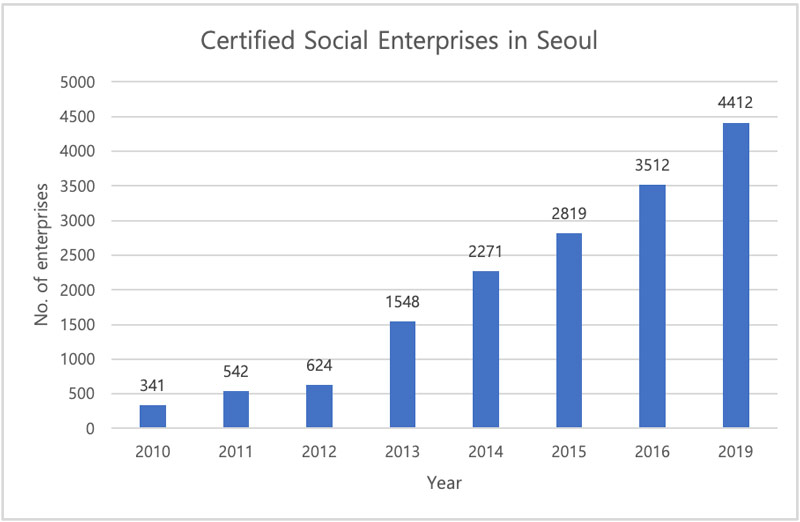
Village Community Enterprises
Village Community Enterprises are social enterprises rooted in specific neighborhoods and run by residents. One of the first began in the late 1990s and early 2000s, when residents in the Sungmisan Village area of Seoul (the national capital city) fought gentrification by building various co-ops—including childcare co-ops, a resident-run café, a theater, bookstore, and school, and several cooperative housing projects.
Building on the Sungmisan Village’s success, Seoul officials followed the national 2011 Village Community Act (which created the legal category of village community enterprises at the national level) by passing a 2012 Seoul Village Community Initiative Act, with a goal “to grow and diversify village communities for achieving autonomy and improving democracy” (629).
These Seoul initiatives helped catalyze Korea’s national Village Community Promotion Program. To receive government certification, village enterprise initiatives must meet “community” ownership requirements (with democratic member control), “publicness” (being dedicated to solving public problems), “locality” (being locally rooted and using local resources), and “enterprise” (selling products and services sustainably).4 Seventy percent of certified village-company employees must be local residents. No one person can have more than a 30 percent investment in the enterprise. Two-thirds of profits must be re-invested in the business or go towards social objectives, and organizational decision making must be transparent and democratic.
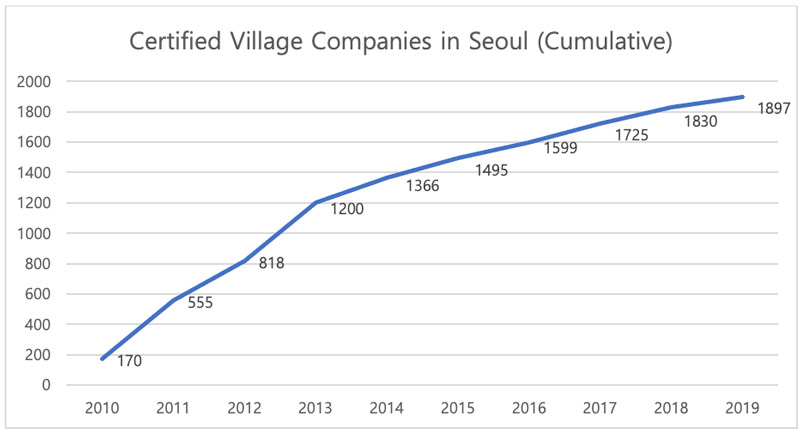
Cooperatives
The passage of the 2011 Framework Act on Cooperatives has also played a critical role in the expansion of a solidarity economy in Korea. Although cooperatives have existed in Korea since the early 20th century—the Nonghyeop agricultural cooperative being one of the largest cooperatives in the world—before the FAC, it was hard to launch a cooperative at the grassroots level in large part because forming a cooperative required at least 200 members and $300,000 in capital. The FAC reduced the minimum required number of people to five and established a simple process to apply for cooperative status, which only requires residents to submit articles of association to their home city or a related jurisdiction.
Under these liberalized rules for forming independent cooperatives, in just the first five years, 8,289 new cooperatives were registered (Jang 2017), and the total number grew to 22,610 cooperatives as of February 2023.
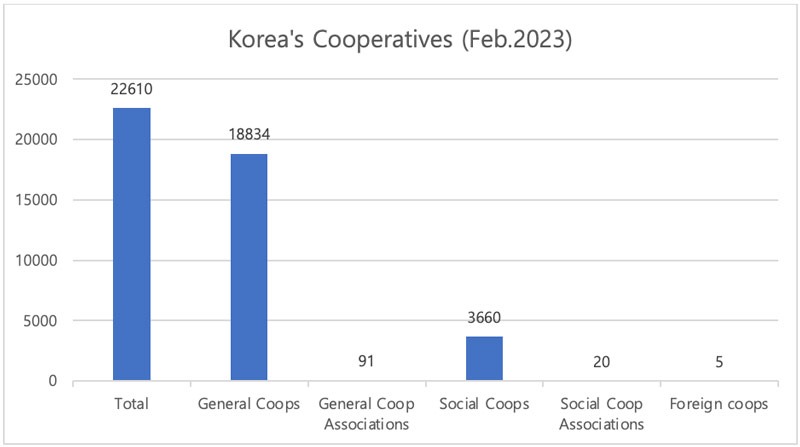
Sign up for our free newsletters
Subscribe to NPQ's newsletters to have our top stories delivered directly to your inbox.
By signing up, you agree to our privacy policy and terms of use, and to receive messages from NPQ and our partners.
Worker Co-ops
The FAC also legalized worker cooperatives. Although, informally, Korea possessed worker cooperatives beforehand, none could formally register as such.
The first legally registered worker cooperative was the Alternate Drivers’ Cooperative, which formed in 2010 before passage of the FAC law. The co-op provides personal drivers to operate customers’ cars when an auto-owner cannot drive themselves (typically because the owner has been drinking). Over 200,000 “alternate drivers” are working on any given night in Korea. Historically, they have had poor working conditions because they have been regarded as independent contractors, much like Uber and Lyft drivers in the United States. Online organizing enabled drivers to form the worker-owned cooperative, and they registered as soon as the new law enabled them to do so.
Additional cooperative efforts followed FAC’s passage. For example, the Happy Bridge cooperative operates a successful restaurant franchise, Guksu Namu (“Noodle Tree”), with over 600 franchise locations in Korea. The company’s five founders were progressive social activists who long had been committed to workplace democracy. They pursued alternative forms of social enterprise for their restaurant, traveling to Italy and Spain to learn about Mondragón—a successful federation of worker cooperatives based in Spain. In March 2013, shortly after FAC went into effect, Happy Bridge founders converted their business to a worker cooperative. As of 2020, Happy Bridge had 96 worker-owners, six pre-worker owners, and 15 employees, generating revenue of more than $50 million.
As of February 2023, there are over 693 worker cooperatives in Korea. Compared to other cooperative sectors, such as consumer cooperatives and/or social cooperatives, the worker cooperative movement has grown slowly. The leader of the Working People’s Cooperative Association, Gangtae Park, points out that Korea’s capitalist economy is deeply suspicious of any worker organizing.6 Shifting mindsets so that people are open to creating an economy that emphasizes collaboration among workers has been a challenge.
Social Cooperatives
Another category of cooperatives under the FAC is social cooperatives, which must register as nonprofits, dedicate at least 40 percent of all income to public benefits, and make no individual dividend distributions. According to SEPA, there were 3,215 registered social cooperatives in 2021 and 3,660 social cooperatives by the end of 2022.
One key national support strategy is encouraging government agencies at all levels to purchase products or services from the social-economy sector
Social cooperatives have been popular among social-service providers, especially in the fields of child and elder care. Although Korea has one of the largest aging populations among all OECD countries, there are inadequate agencies or facilities to care for aging people. FAC’s passage helped change the landscape of child- and home-care work in Korea by facilitating nonprofit self-help efforts among lower income communities.
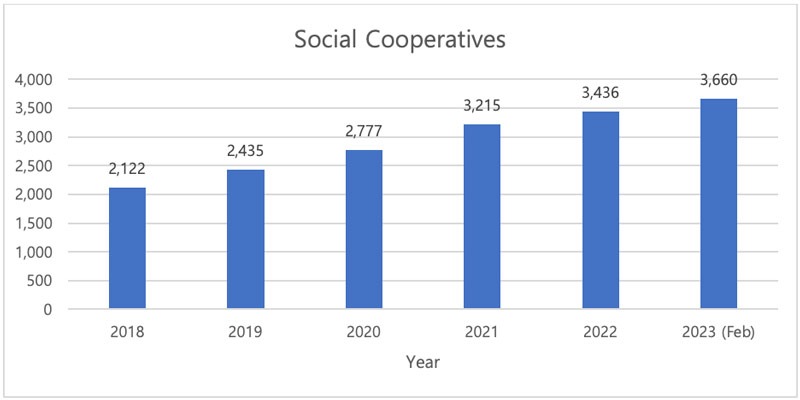
The Role of Government Procurement
One key national support strategy is encouraging government agencies at all levels to purchase products or services from the social-economy sector. In 2014, Seoul passed two related ordinances, the “Public Purchase and Marketing Support for the Products of Social Economy Enterprises” and “Public Procurement for Realization of Values.” The first social-responsibility public-procurement ordinances in Korea, they were meant to help social enterprises increase their market share and sustain long-term operations.
They required public agencies to seek out the products and services of self-reliance and social enterprises, village communities, and cooperatives in their procurement purchases. Public agencies covered by preferential procurement rules included all city departments, including libraries, public hospitals and safety offices, and special-purpose public organizations, like tourism promotion agencies.
To support these agencies’ procurement goals, Seoul established a Social Economy Public Purchase Sales Support Group in 2014 with a mission to help social enterprises effectively enter the public procurement market. The city also established an online system, which helps match public organizations with the products and services of social-economy enterprises. Soon after its creation, the online portal had 7,000–8,000 average monthly visitors. In 2018, the portal facilitated the first attempt in Korea to analyze a municipal budget to proactively identify social-economy products that public organizations might purchase.
Seoul has also organized an annual expo so that social-economy representatives and procurement officials can network. Over time, local government purchasing from social enterprises increased from KRW $50 billion in 2012 (about US $38 million) to KRW $136.9 billion in 2018 (about US $103 million). As of 2017, about 1.3 percent of total city purchases came from social-economy enterprises, with city leaders pushing for even more aggressive preferential procurement strategies.
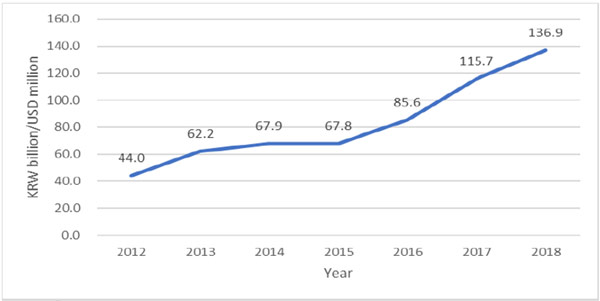
The national government followed suit in 2017, passing legislation to create a nation-wide preferential procurement plan. All government sectors must now report overall spending and total social-economy sector purchases to the Ministry of Employment and Labor—and track their progress in achieving purchasing goals. An online mall (Store 36.5) has been created through which public agencies can access the Social Economy Exclusive Store for their procurement needs. These public procurement ordinances together with online product marketing have been effective, prompting social-economy purchases by public agencies nationwide to increase more than fivefold (16) from 2012 to 2018.
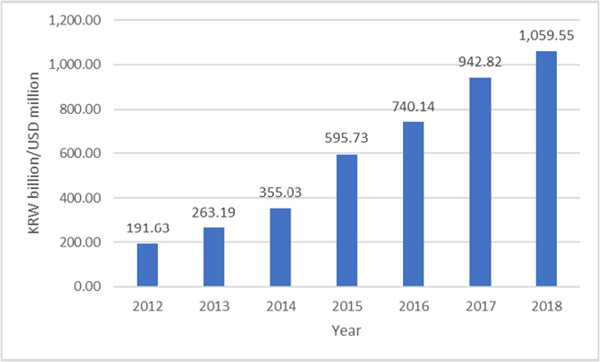
Conclusion: Towards a Social-Economy Ecosystem
Community activists on the ground are striving to forge a social economy profoundly different than that of acquisitive capitalism.
Building a social-economy ecosystem takes a village. In the case of Korea, the strategy of fostering diverse social-enterprise programs emerged in the wake of an economic crisis, and indeed, the rapid growth of Korea’s social-economy sector could not have happened without various policies and laws passed to support a locally grounded economy.
Although chaebols still dominate the Korean economy, the effort to create locally rooted alternatives has been growing. Community activists on the ground are striving to forge a social economy profoundly different than the world of acquisitive capitalism. While there is a long way to go, Korea’s example provides a model for how government policy and procurement can advance a social and solidarity economy.
In the United States, we’ve seen modest policy efforts in this direction, such as the creation of an employee ownership office in Colorado. As the example from Korea shows, over time, much more is possible.
Notes
- USRISD (United Nations Research Institute for Social Development), “Social and solidarity economy for Sustainable Development Goals: spotlight on Seoul,” Geneva, 2018, https://www.unrisd.org/en/ research/projects/social-and-solidarity-economy-forthe-sdgs-spotlight-on-the-social-economy-in-seoul.
- Ibid.
- L. Kwark, “Social solidarity economy (SSE) as a tool and public policy to localize SDGs: Case of Seoul,” Global social economy forum, Seoul, 2016; UNRISD, “Social and solidarity economy”; and KS Yoon and SY Lee, “Policy systems and measures for the social economy in Seoul,” UNRISD working paper 2020.
- Seoul City Village Cooperative Support Center, “2020 Eyun Jachigu Maeul Sangtaegye Josungsaeup Pyunggajipho gaebal eyungu bogoseo,” 2020 Autonomous district village ecosystem creation project evaluation index development research report.
- Data gathered from: Choi et al, “Research on Cooperation Strategy with the Private Sector,” Korea Institute of Procurement, December 2020. The 2022 statistics for certified village companies in Seoul is 1,592. See http://kmaeul.or.kr/business/business02.html
- Interview with Gangtae Park, February 2012.













